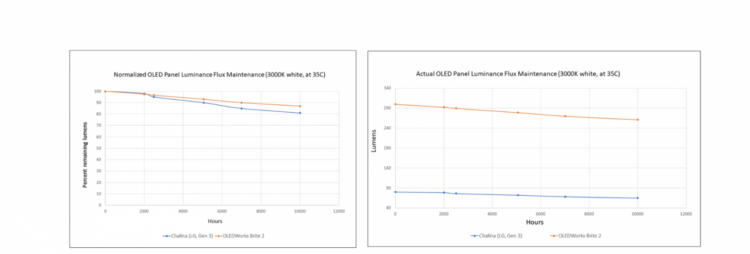
Originally published in Information Display
OLED is truly a special kind of lighting. As a surface light source, it illuminates space uniformly and provides beautiful light quality. Because of its excellent color rendition, OLED reproduces objects’ color clearly and accurately. Its soft, natural light offers multiple functionalities while improving light sources’ aesthetics.
With this superb light quality and unique design elements, OLED lighting is gaining ground and tracking a similar trajectory to LED lighting. The first LEDs with practical use emerged in the 1960s. After the invention of the ultra‐bright blue LED by Shuji Nakamura in 1994, the development of white LEDs as a replacement for other light sources accelerated. Ching Tang and Steven VanSlyke invented the first heterostructure OLED in 1987. In the beginning, OLED technology’s primary use was in the display industry; now, OLED for lighting is rapidly innovating and increasingly relevant. Philips introduced the first commercially available OLED lighting panels in 2009, with a power efficacy (PE) of 20 lumens per watts (lm/W) and a lifetime of 10,000 hours.(1)
Since then, significant improvements in efficiency and operational stability were made; today’s commercial panels are available with a PE of 85 lm/W and lifetime of 100,000 hours.(2) Indeed, OLED lights are a valid and proven solid‐state lighting (SSL) technology. Currently, a prevalent topic in the lighting industry is the effect of lighting on human health—particularly, the human vision system. While LED SSL offers many advantages, it also carries concerns.
For instance, compact, high‐power LED fixtures produce considerable glare. Also, LEDs are susceptible to temporal light modulation (a flicker effect), resulting in detrimental health effects. A recent report by the French Agency for Food, Environmental, and Occupational Health and Safety states that “in general LED lighting system[s] increase the imbalance of wavelengths in favor of blue light compared to red light, in comparison with other lighting systems, at the same color temperature.”(3) Exposure to blue light in the range of 450–470 nanometers (nm) is thought to cause irreversible eye damage.
OLED light is unique in that it is a surface light source and emits soft light, making it possible to place it near the user in desk lamps and sconces, for example. With Lambert’s cosine light distribution, OLED lighting creates a non‐glare experience, mitigating eye fatigue and improving task performance. With the proper driver, flickering is never an issue for OLED. Humans need blue light for good color rendering and for syncing our circadian rhythm to local time. White OLED’s spectrum has less blue light on the short wavelength side and offsets this with more of the longer‐wavelength, less‐damaging blue light.
OLED lighting has diverse applications, including general lighting, automotive, healthcare, and packaging. OLED can be used for illuminated logos, texts, pictures, and cards. Some rather unique, useful features are that OLED panels are ultrathin and lightweight, with flexible options available, thereby expanding creative design freedom. With no need for heatsinks, OLED panels’ thinness and brightness enable easy integration as surface mounts or to illuminate small spaces. OLED light’s soft glow is a nice complement to LED SSL’s high brightness.
Creative Applications
This lighting‐themed issue of Information Display includes two features that highlight the most innovative trends in OLED SSL technology. Car manufacturers have introduced OLED taillights in their luxury models, and the article “An OLED Taillight Revolution,” by Audi’s Michael Kruppa, Ph.D., Werner Thomas, Ph.D., and Wolfgang Huhn, Ph.D., explores the advantages of doing so. Dr. Kruppa, Dr. Thomas, and Dr. Huhn explain how OLED’s extremely uniform light cannot be imitated by using LEDs with reflectors or light‐guide films. They also detail taillights’ performance requirements: 2,000 candelas per square meter (cd/m2) brightness, with a deep‐red color with CIE x, y of (0.7, 0.3), and a dominant wavelength > 625 nm. OLEDs must pass high temperature stability tests, as well.
In Addition, “Ultrathin Glass Substrates for Thin, Lightweight, Flexible OLED Lighting” by Corning’s Sean Garner, Ph.D., Dipak Chowdhury, Ph.D., and Sue Lewis provides an overview of their ultrathin Willow Glass technology. Plastic‐based OLED lighting panels are quite susceptible to damage and premature defect formation, because of oxygen and water ingress. OLED panels that use a paper‐thin glass substrate rather than barrier‐coated plastic have multiple advantages, including an increased lifetime, optical and surface quality, thermal stability, and chemical compatibility. Thus, the development of flexible white OLED lighting panels should result in novel lighting solutions. A light source’s flexibility and bendability will be an important feature for general lighting and automotive applications.
With improved efficiency and lifetime, OLED products have captured customers’ attention and loyalty and continue to gain strength across multiple markets. I thank all the authors for contributing articles and sharing their perspectives about the tantalizing developments in OLED lighting technology. I hope readers enjoy them, as well.
Biography
Marina Kondakova, Ph.D., is the director of device formulation at OLED Works. She can be reached at mkondakova552@gmail.com.
References
1 Kunkel T and Reinhard E. A reassessment of the simultaneous dynamic range of the human visual system. Proceedings of the 7th Symposium on Applied Perception in Graphics and Visualization; 2010 Jul 23-24; Los Angeles. New York: ACM; 2010. p. 17-24.
2 Fernandez EJ, Prieto PM, and Artal P. Wave-aberration control with a liquid crystal on silicon (LCoS) spatial phase modulator. Optics Express, 2009 Jun 22;17(13):11013-25.
3 Damberg G, Boitard R, Ballestad A, and Heidrich W. Light steering projection systems and attributes for HDR displays. SID Symposium Digest of Technical Papers. 2017 May;48(1)87-90.


![[eBook] OLED Lighting for Automotive Solutions](https://www.oledworks.com/wp-content/uploads/2022/02/Automotive-eBook-Header-750x254.png)
